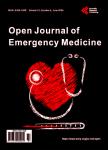Improved Resuscitation Method for Choking Victims
Improved Resuscitation Method for Choking Victims作者机构:Independent Researcher Odessa USA
出 版 物:《Open Journal of Emergency Medicine》 (急诊医学(英文))
年 卷 期:2021年第9卷第4期
页 面:143-149页
主 题:Abdominal Thrust Choking Food Bolus Heimlich Maneuver Resuscitation
摘 要:Abdominal thrust, popularized by Henry Heimlich in 1975 is the standard resuscitation method for victims of choking. When properly applied, this procedure can and has saved many lives over the years, but the process itself is somewhat difficult to perform. The main reason for this difficulty is the need to reach around the trunk of the victim and then apply sufficient force to generate enough pressure upwards to the diaphragm, to be able to dislodge the food bolus (or foreign body) out of the larynx. This is compounded by the size of the average American, especially when they are overweight or obese, thus the ability to reach the front of the abdomen and then the prospect of actually trying to lift the victim up through brute force is a challenge for most people. Some difficulties are inherent in the emotionally charged and panicky situations in which such resuscitation measures take place. Some scientists have advocated the use of mechanical devices to apply thrust to the abdomen. However, the lack of availability of such assisting devices at home and even in restaurants is a distinct issue. Damage to the xiphisternum or internal organs by excessive force is also an issue, so much so, most authorities recommend a post-resuscitation check up of all victims at a hospital or clinic. The procedure(s) described in this report is much simpler in execution, while being almost effortless, and applicable to victims of any size. It also exploits the objects that are likely to be present where such choking accidents occur, the restaurants and dining rooms, while also taking advantage of the earth’s gravity to dislodge the offending food bolus. If such objects are not available, an alternate method using the rescuer’s free forearm to support the victim’s weight, while keeping him/her folded over is also described.



